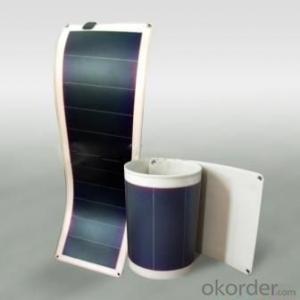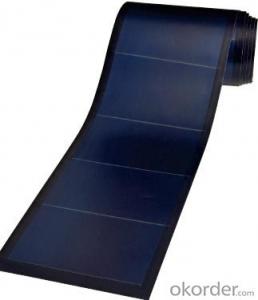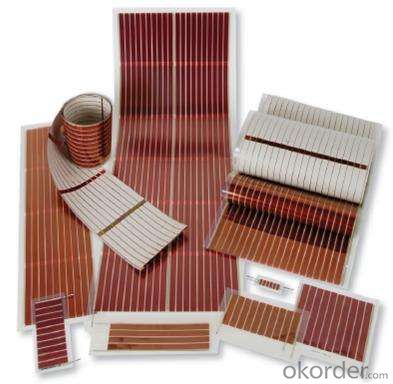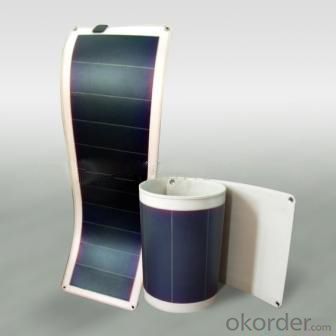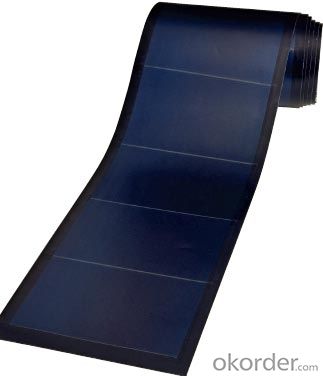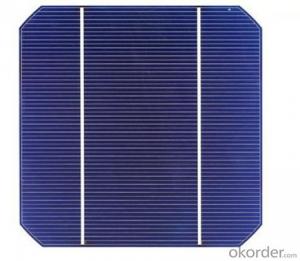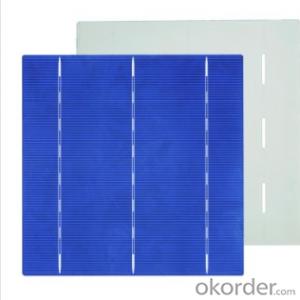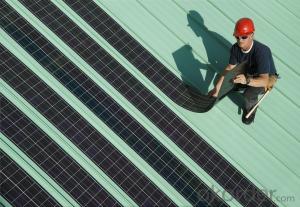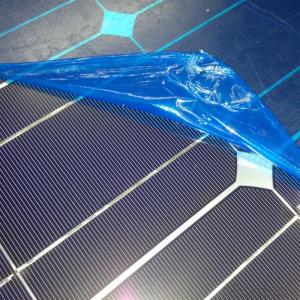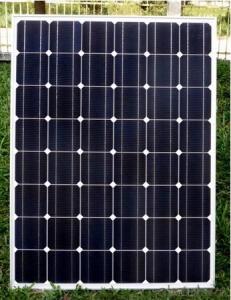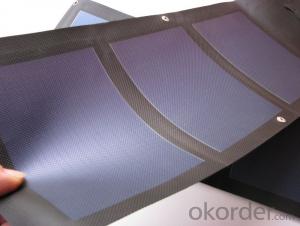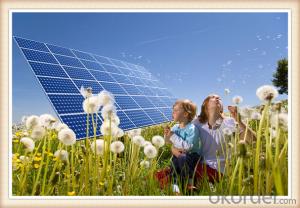China Flexible Solar Cell Roll with Long-term Stability,Reliability and Performance
- Loading Port:
- Tianjin
- Payment Terms:
- TT or LC
- Min Order Qty:
- 10 pc
- Supply Capability:
- 10000 pc/month
OKorder Service Pledge
OKorder Financial Service
You Might Also Like
solar cells in stock with immediate delivery with big quantity, all range cells avaiable, mono multi avaiable
Quality and Safety
1.Rigorous quality control meeting the highest international standards
2.High-transmissivity low-iron tempered glass, strong aluminium frame
3.Using UV-resistant silicon
4.ISO 9001:2008 and ISO 14001:2004
5.IEC61215, IEC61730, Safety Class in conformity to CE
Features
1.High conversion efficiencies resulting in superior power output performance.
2.Outstanding power output even in low light or high temperature conditions
3.Optimized design for ease of soldering and lamination
4.Long-term stability,reliability and performance
Warranties
1.10 years limited product warranty
2.15 years at 90% of the minimal rated power output
3.25 years at 80% of the minimal rated power output
Format: 125mm x 125mm
Thickness: 190um+-20um
Front(-): 1.7mm bus bars(silver),blue anti-reflecting coating(silicon nirtride)
back(+): 3mm wide soldering pads(silver) back surface field(aluminium)
Size | 125mm x125mm ±0.5mm | |||||
| Thickness | 190um ± 20um | |||||
| Front surface(-) | 1.7mm bus bars(silver), blue anti-reflecting coating(Silicon nitride) | |||||
| Back surface (+) | 3mm wide soldering pads(silver) back surface field(Aluminum) | |||||
| TkVoltage | -0.348%/K | |||||
| TkCurrent | +0.031%/K | |||||
| TkPower | -0.46%/K | |||||
| Efficiency(%) | Pmp(W) | Vmp(V) | Imp(A) | Voc(V) | Isc(A) | FF(%) |
| 17.75-18.00 | 2.66 | 0.533 | 4.986 | 0.630 | 5.327 | 79.24 |
| 17.50-17.75 | 2.62 | 0.528 | 4.959 | 0.629 | 5.297 | 78.60 |
| 17.25-17.50 | 2.54 | 0.519 | 4.906 | 0.628 | 5.270 | 76.74 |
| 16.75-17.00 | 2.50 | 0.512 | 4.884 | 0.628 | 5.262 | 75.70 |
| 16.50-16.75 | 2.47 | 0.509 | 4.861 | 0.627 | 5.254 | 75.00 |
| 16.25-16.50 | 2.43 | 0.527 | 4.798 | 0.626 | 5.245 | 74.07 |
| 16.00-16.25 | 2.40 | 0.545 | 4.754 | 0.625 | 5.237 | 73.34 |
| 15.75-16.00 | 2.36 | 0.502 | 4.696 | 0.624 | 5.228 | 72.34 |
| 15.50-15.75 | 2.32 | 0.500 | 4.636 | 0.621 | 5.180 | 72.12 |
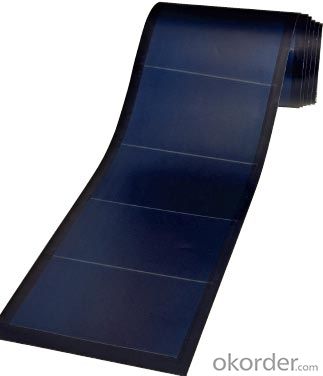
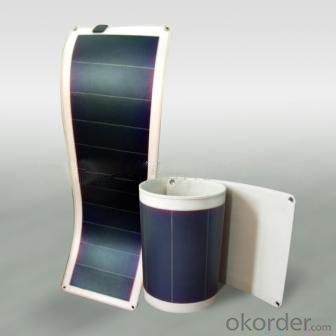
Working Principle of Flexible Solar Cell Roll
Metal surface irradiated with ultraviolet light, the photoelectric effect can occur. As Einstein explained, since the incident photon energy is greater than the binding energy of the electron, the free electrons. Solar cell function is to convert sunlight into voltage and current, a photoelectric conversion. Photovoltaic effect is much higher than the efficiency of the photovoltaic effect. Since the occurrence of the photovoltaic effect of the solar cell, the two kinds of semiconductors of opposite polarity p-n junction (p-n Junction), formed in electric field, enter the electronic drive circuit that forms a voltage and current in the circuit.
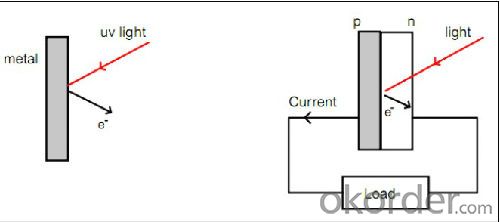
Characteristics of Flexible Solar Cell Roll
Flexible thin-film solar cells three characteristics:
"Can curl", it can be easily installed on the roof or outside irregular vehicle; "lightweight" stainless steel substrate thickness of only 0.127 mm, very thin; "low installation cost," Xun both energy photovoltaic cell production business, but also the production designer and manufacturer of the device, so the low cost of electricity.
Bright sun and wind, people resting on the lawn, someone took out a curled or folded like paper solar cell module from the backpack, start to shop, even on laptops, mobile phones, digital cameras charge. This is not science fiction, but reality.
The biggest feature is the flexible thin-film solar cells can curl, can be easily installed on the roof or outside irregular vehicle; second major feature of light weight, general solar cell needs to be done to install a metal frame, or to the roof reinforcement, flexible thin-film solar stainless steel substrate thickness of the battery is only 0.127 mm, very thin; the third major feature low installation costs, energy fast force both manufacturers of photovoltaic cells, but also the production designer and manufacturer of equipment, so the low cost of power generation, considering, flexible battery is the best.
- Q: Can solar cells be used in greenhouses or agricultural facilities?
- Yes, solar cells can be used in greenhouses or agricultural facilities to generate clean and renewable energy. This can help reduce reliance on traditional energy sources and lower carbon emissions. Additionally, solar cells can provide a consistent power supply for various agricultural operations, such as lighting, ventilation, and irrigation systems, enhancing productivity and sustainability in these facilities.
- Q: How does the efficiency of solar cells vary with different materials?
- The efficiency of solar cells varies with different materials due to their unique properties and ability to absorb and convert sunlight into electricity. Certain materials, such as monocrystalline silicon, have high efficiency rates due to their ability to efficiently convert a larger portion of sunlight into electricity. On the other hand, materials like amorphous silicon or thin-film solar cells have lower efficiency rates but offer other advantages such as flexibility and cost-effectiveness. Overall, the efficiency of solar cells is heavily influenced by the materials used and their specific characteristics.
- Q: Can solar cells be used in theme parks or amusement parks?
- Yes, solar cells can be used in theme parks or amusement parks. Solar panels can be installed on rooftops, parking structures, or open areas within the park to generate renewable energy. This energy can be used to power rides, lighting, and other facilities, reducing reliance on traditional electricity sources and lowering operating costs. Additionally, incorporating solar technology aligns with the sustainable and eco-friendly image that many theme parks strive to promote.
- Q: Can solar cells be used in space satellites?
- Yes, solar cells can be used in space satellites. In fact, solar cells are the primary source of power for most satellites in space. They convert sunlight into electricity, providing a reliable and renewable source of energy for various satellite operations.
- Q: Which one is better on the solar cells panel? The Monocrystal Solar Energy Cell or photovoltaic cell?
- Since most of people I know, the function of the solar cell is for some home-based lighting and watching TV, it doesn't really matters if it is Single crystal silicon or polycrystalline silicon solar energy cell.
- Q: How can the huge solar cells be applied into the market?
- The huge solar cells are more used in the industrial project, which needs more power supply in one time. Without the huge solar cells, it might not be able to work at all.
- Q: Are solar cells weather-resistant?
- Yes, solar cells are weather-resistant. They are designed to withstand various weather conditions, including rain, snow, and extreme temperatures, without significant damage to their functionality.
- Q: Can solar cells be used for powering amusement parks?
- Yes, solar cells can be used for powering amusement parks. Solar energy can be harnessed through solar panels, which can generate electricity to power various rides, lighting systems, and other infrastructure within the park. It is a sustainable and environmentally friendly alternative to traditional energy sources, reducing the carbon footprint and operating costs of the amusement park.
- Q: Can solar cells be used in electric fence systems?
- Yes, solar cells can be used in electric fence systems. Solar cells convert sunlight into electricity, which can be used to power the electric fence. This eliminates the need for traditional power sources such as batteries or connecting to the electrical grid, making it a more sustainable and cost-effective option.
- Q: How do solar cells perform in areas with frequent hurricanes?
- Solar cells can still perform well in areas with frequent hurricanes, provided they are designed and installed with specific considerations in mind. Reinforced mounting systems, robust construction materials, and proper installation techniques can enhance the durability of solar panels against strong winds and debris. Additionally, grid-connected solar systems with battery storage can provide reliable power during power outages caused by hurricanes, making them a resilient energy solution for such areas.
Send your message to us
China Flexible Solar Cell Roll with Long-term Stability,Reliability and Performance
- Loading Port:
- Tianjin
- Payment Terms:
- TT or LC
- Min Order Qty:
- 10 pc
- Supply Capability:
- 10000 pc/month
OKorder Service Pledge
OKorder Financial Service
Similar products
Hot products
Hot Searches
Related keywords

